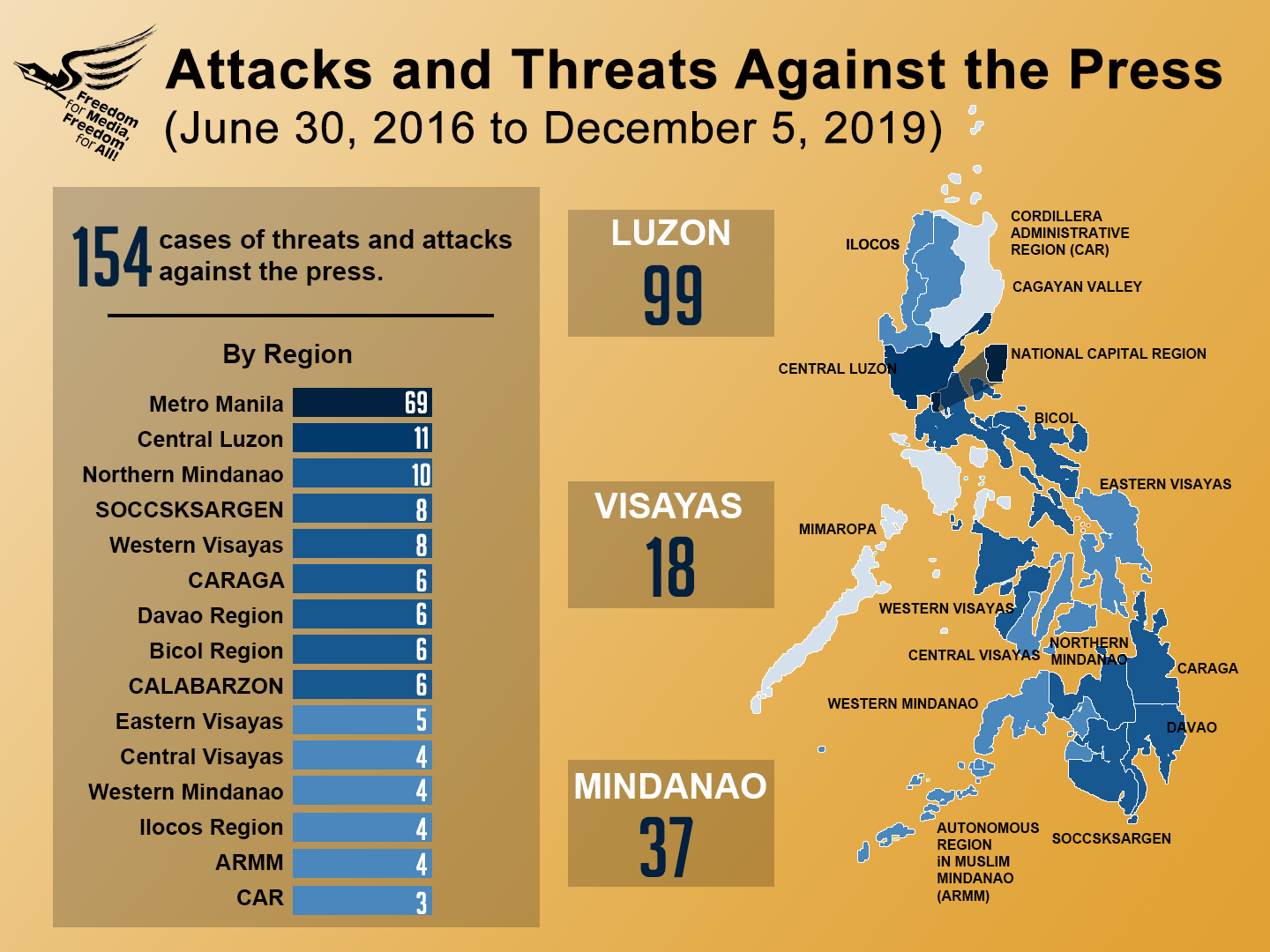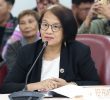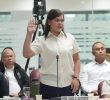DAVAO CITY, Philippines – Fifteen media practitioners have been killed since President Rodrigo Duterte rose to power in 2016 — a revelation that despite his promise of change, this sector of society can’t and won’t be spared from vicious attacks.
Under Duterte, journalists and news outlets received a mouthful because of their effort to inform the public of the significant issues at hand. The administration has a reputation of bullying, with threats, restrictions, cyber-attacks, and murder against journalists. These have kept the country as the deadliest for media workers in Asia.
The lack of justice for the victims and their families in the past three years, only added to the high numbers since 1986, when the country has supposedly been freed from dictatorship.
Though the administration established Presidential Task Force on Media Security (PTFoMS), this did not ensure the safety and security of journalists, since the oppressive working environment around them continues.
In the last six months, a significant increase in the number of cases of killings, attacks, and threats was noted: from 128 cases to 154 cases, across media platforms in the country.
The data is based on the report released on Dec 10,2019 by the Freedom for Media, Freedom for All Network (FFMFFAN) which is composed of the Center for Media Freedom and Responsibility, National Union of Journalists of the Philippines (NUJP), Philippine Press Institute, MindaNews, and the Philippine Center for Investigative Journalism.

Killings in Mindanao
Out of the 15 cases of media killings under Pres. Duterte, eight of them were from Mindanao: broadcaster Apolinario Suan, Jr. on July 2016, radio block timer Marlon Muyco on February 2017, reporter Leo Diaz in Sultan Kudarat and broadcaster Rudy Alicaway on August 2017, broadcaster Christopher Lozada on March 2018, publisher Dennis Denora on June 2018, broadcaster Eduardo Dizon on July 2019, and radio station manager Benjie Caballero in December this year.
The NUJP media safety office noted that the perpetrators of these killings were unidentified, wore ski-masks, and most of the time rode in tandem. Most of those killed, it added, are either going out from their houses or on their way home.
Martial Law in Mindanao
In May 2017, Pres. Duterte put the entire Mindanao under Martial Law as “the way to combat the rising threat of Islamic militancy,” following the attack in Marawi City by the ISIS inspired Maute group which resulted to thousands of evacuees and the massive destruction of houses and infrastructures.
When the Philippine Armed Forces took over Mindanao, they censored the press and social media for the so-called “protection of national security.”
Then Philippine Army spokesperson Brigadier General Restituto Padilla said that part of ensuring safety is the censorship of the media based on three conditions: “One, to ensure the safety of lives, second to ensure operational security and ensure the safety of our men in uniform who are fighting, and for other national security considerations.”
Because of censorship, the public received limited details of the Marawi siege when Task Force Bangon had to conceal the available information when the war was ongoing.
Journalists had to rely most of the details of the war from military reports, including the number of casualties and identities of the dead in the battlefield, the number of war materials used to ensure the defeat of the Maute group in the months-long combat operations, and the exact plan of rehabilitation of the Islamic City.
Red tagging, online attacks
In other parts of Mindanao, censorship comes with other forms of attacks.
The FFMFFAN reported an increase on the number of incidents of intimidation, including red tagging from six to 16 cases this year.
Media organizations and outlets, including their officers and members, were accused as associated in the “Oust Duterte plot matrix.” The said matrix contained the alleged destabilization efforts made by the accused, and later the opposing political parties.

Radyo ni Juan, a community media network; Radyo Lumad, a community radio station in Bukidnon; and Davao Today, an online news magazine had been tagged as supporters of the Communist Party of the Philippines (CPP) and its armed wing, the New People’s Army (NPA).
Davao Today and its columnist XL Fuentes became subjects of cyber-attacks by Facebook (FB) community page Lapu-Lapu which regularly shares pro-government, anti-communist, and military-produced materials.
Journalists Froillan Gallardo of MindaNews, Pam Orias of Sunstar Cagayan de Oro, Margarita Valle of Davao Today, and Cong Corrales of Mindanao Gold Daily were also victims of red tagging and death threats.
Orias and Valle were in a graphic posted by FB page, Quiet No More PH, on July 12. It came with a caption: “Warning: Beware of these people and organizations. They are protectors of the CPP-NPA terrorists.”
While Gallardo and Corrales were red tagged in August, their names were also included in an anonymous material sent to the Cagayan de Oro Press Club office and the Cagayan de Oro City Hall accusing them as sympathizers of the Communist group.
A flyer produced by a certain Black Mamba of the “MAT-NMR Press Club Chapter” claimed that Corrales is a high ranking official of the NPA and that he has a criminal rape and murder case involving a child. A P1-million bounty for his death was also noted.
Veteran journalist Julie Alipala was also subjected to cyber-attack and death threats on social media after reporting about the death of seven young Tausugs who were killed by the military. The minors were earlier identified by the military as members of Abu Sayyaf.
Alipala’s report to inquirer.net last September 2018 drew negative comments from netizens such as “Magkano kaya ang binayad kay Julie Alipala? Pati teroristang Abu Sayyaf pinagtatanggol niya! Certified bayarang kolumnista!” (How much was paid to Julie Alipala? She is defending even the terrorist Abu Sayyaf! A certified paid columnist!).
Abduction
Last June, operatives of the Criminal Investigation and Detection Group in Region 9 illegally arrested Valle while waiting for her flight home to Davao City.
Valle was arrested by virtue of an arrest warrant issued in Misamis Occidental by Judge Bernadette Paredes-Encinarea against “Elsa Renton/Tina Maglaya” and later on included the name of Fidelina Margarita Valle y Avellanosa.”
She was charged for alleged “multiple murder with quadruple frustrated murder and damage to government property with no bail recommended” as well as arson issued by Judge Aniceto Galon Jr. of Pagadian City on September 4, 2006 with bail recommended at 24,000 pesos.
The PNP said Valle has a “huge resemblance” with the wanted person said to be a high-ranking NPA in Western Mindanao identified by their witness. Later, the police apologized for the case of “mistaken identity.”

Davao Today columnist Margarita Valle. (Photo courtesy of Kodao Productions)
Valle had to brave six hours of no communication to her family and workmates, preventing her to see the arrest warrant and seek legal counsel on her situation as she is illegally detained in Pagadian City.
NUJP questioned and condemned the abduction of Valle saying, “this is the equivalent of “shoot now, ask questions later.”
Valle sued PNP Chief Gen. Oscar Albayalde, PNP Spokesperson PCol. Bernard Banac, BGen. Jacinto Bareng of the 1st Infantry Division of the Philippine Army and 13 other operatives for kidnapping, serious illegal detention, violations of the Anti-Torture Action, among others at the Office of the Ombudsman. (davaotoday.com)










